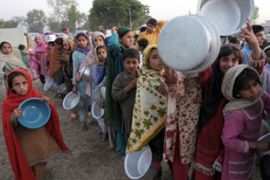Swat refugees tell of abandonment
Military to maintain its offensive against Taliban fighters in North West Frontier Province.

“Some of them died on the road, but no one was willing to offer us any help – neither the army nor the Taliban.
“They are both committing atrocities and cruelty against the ordinary people.”
It was not possible for Al Jazeera to verify accusations of atrocities.
Civilian exodus
About half a million people are believed to be leaving the region, in addition to more than 550,000 people already displaced from Swat and nearby areas since August.
| In video |
|
|
The army lifted its curfew on the area briefly on Sunday to allow residents to flee, before imposing it again with a “shoot on sight” order for anyone who violated it.
Many of those fleeing have headed to nearby villages, but thousands more are gathering at any of 11 refugee camps around the province.
Reporting from Islamabad, the capital, Al Jazeera’s Sohail Rahman said: “That exodus of civilians continues … it’s a desperate situation.
“Those that have managed to escape the Swat valley during that curfew period on Sunday are certainly making thier way to those camps in and around the southern part of the region, and outside Peshawar, the provincial capital.”
Economic concerns
The offensive has been praised by the US, which wants Pakistan to root out havens where Taliban fighters are said to plan attacks on American and Nato forces fighting in Afghanistan.
| In depth |
|
|
But analysts warn that the military’s campaign will have severe knock-on effects in terms of the local economy, which in Swat has become dominated by agriculture in the years since its position as a tourist destination faded.
“They [those fleeing] will be losing their agriculture, their livestock … in addition to that, their houses and their family networks,” Zafar Jaspal, a professor at Islamabad’s Quaid-i-Azam university, told Al Jazeera.
“When we look at Swat and these areas’ agriculture, number one is fruit – and fruit trees need care. If no one is there, how can they care [for] them? Number two is that it is the harvest season for the wheat crop and who will go for harvesting?
“It has not only a short-term implication but a long-term implication in the economic sector.”
Offensive continues
Despite the concerns, the military’s campaign shows little sign of letting up, with Rehman Malik, Pakistan’s interior minister, on Monday vowing that the operation will “continue until the last” fighter has been ousted.
He said that the military had already killed up to 700 fighters.
Military aircraft pounded Taliban positions close to Mingora, Swat’s main town, early on Monday, and there were reports that the army had jammed FM radio station run by the Taliban in Swat.
“It was through those FM stations that they were able to pass their information and go on a campaign of their own, a propaganda campaign,” Kamal Hyder, Al Jazeera’s correspondent in Peshawar, said.
But in a reminder of the dire security situation faced by those displaced by the fighting, a suicide blast at a checkpoint outside Peshawar killed as many as 10 people, police say, and wounded dozens more.
Officials said that a man detonated a car full of explosives on the outskirts of Darra Adam Ghek.
The bomb site and a nearby tunnel were sealed off, while the injured are being taken to hospital, a military official said.

 Mass exodus from Swat
Mass exodus from Swat